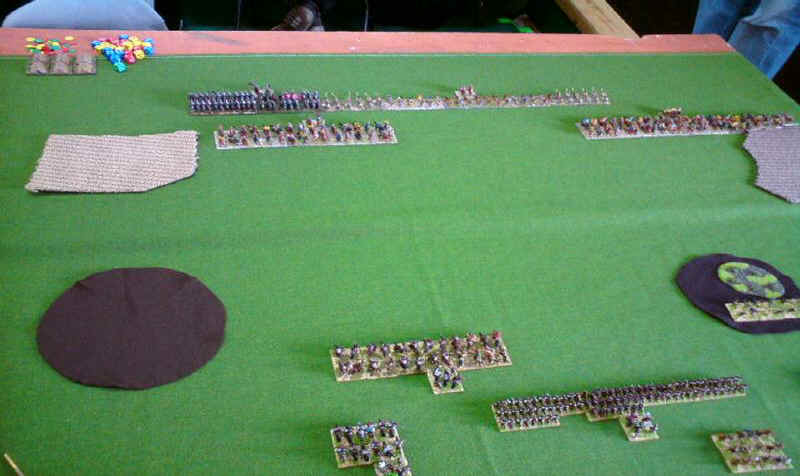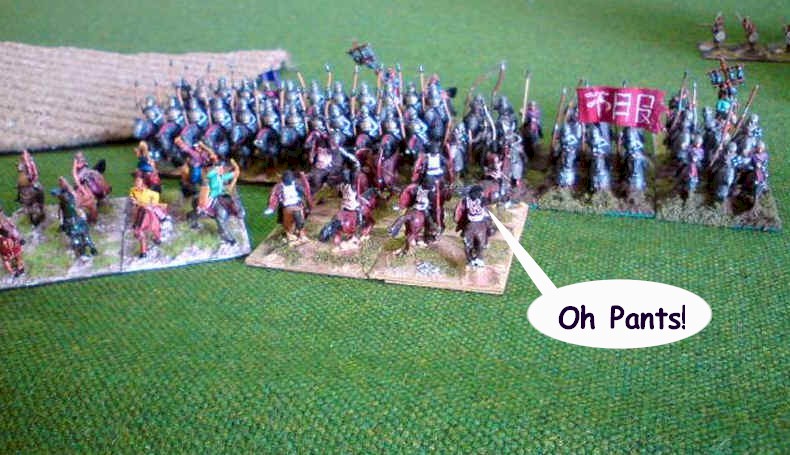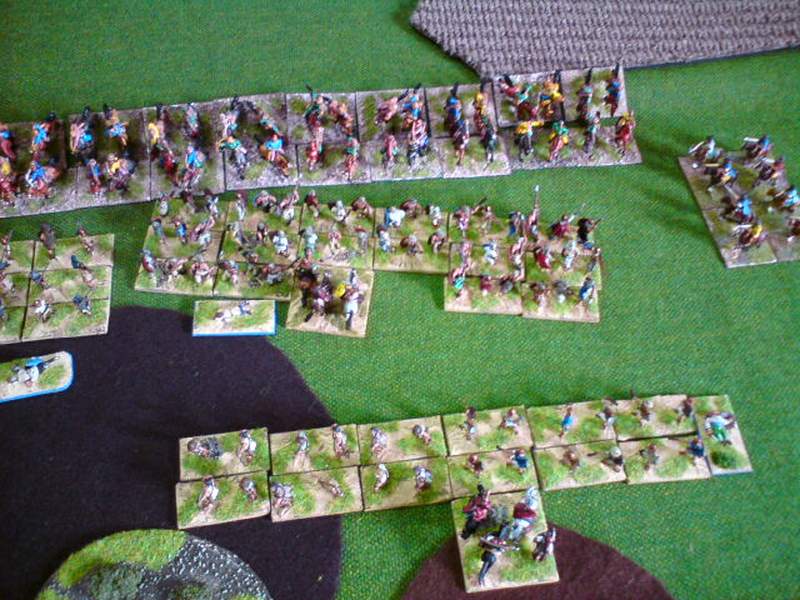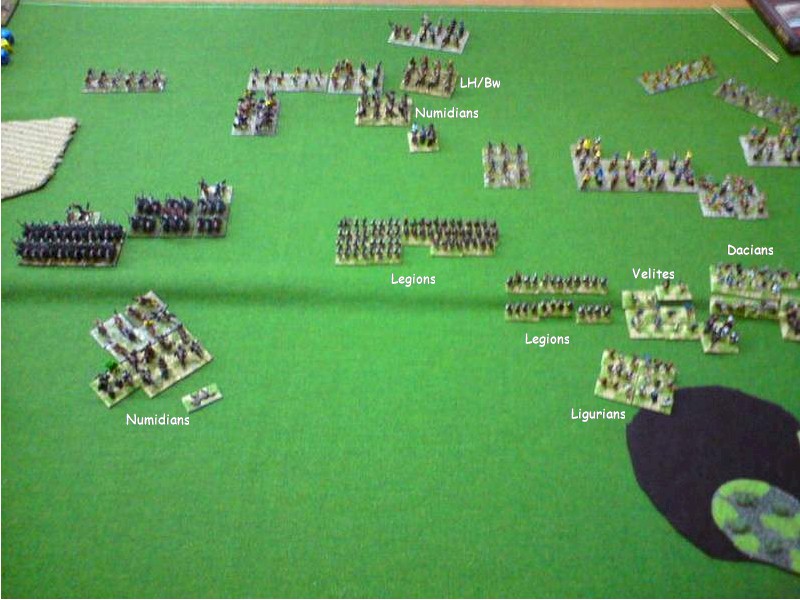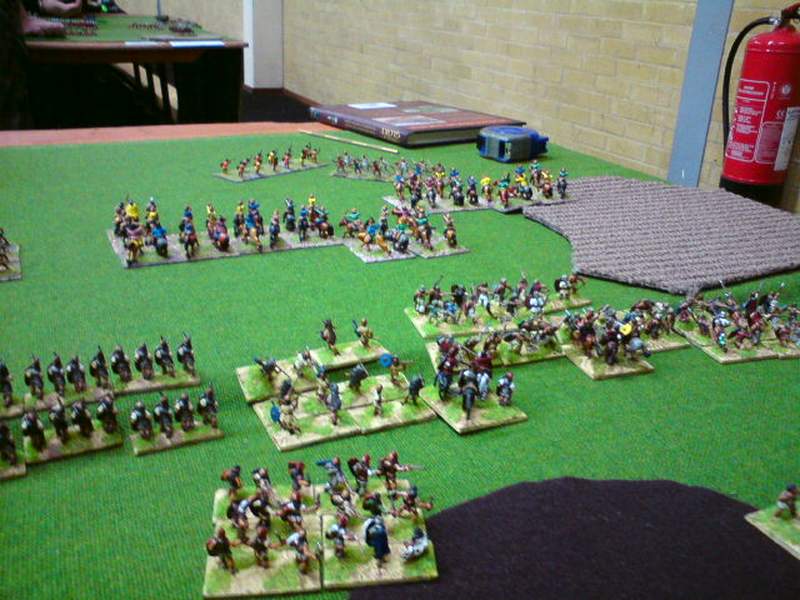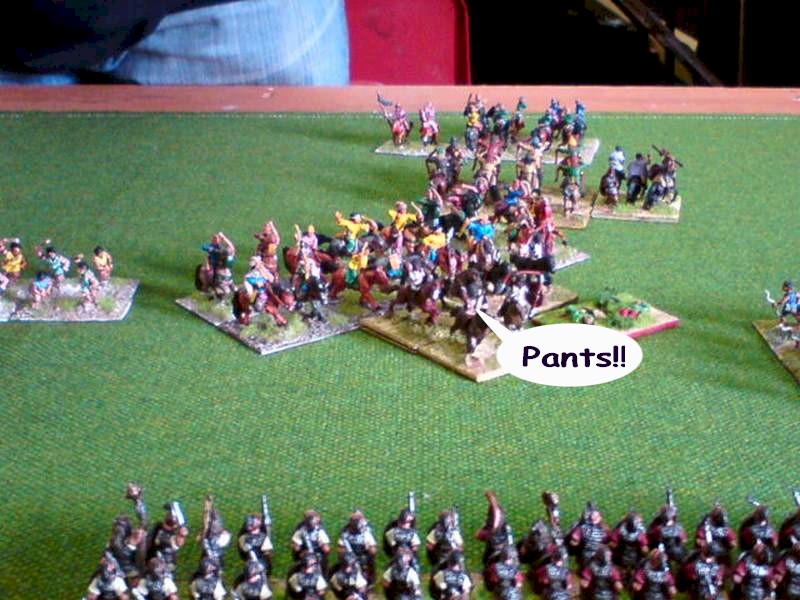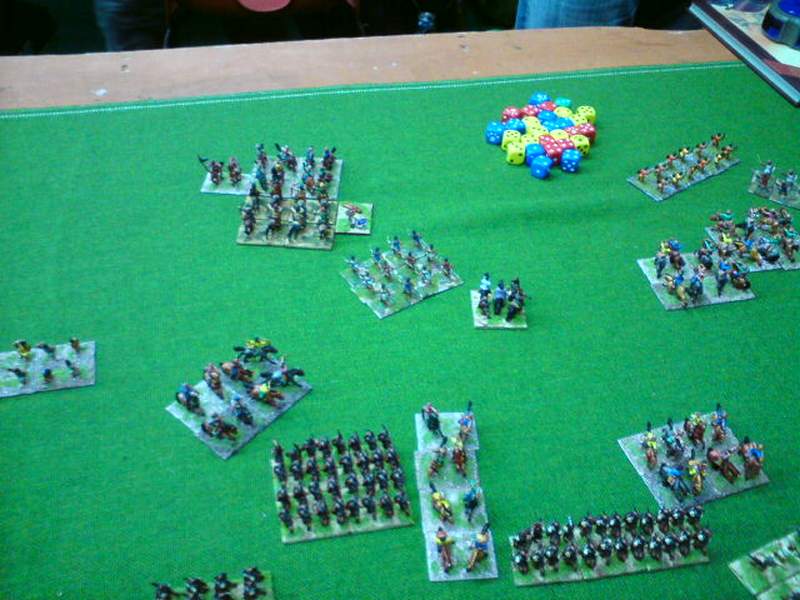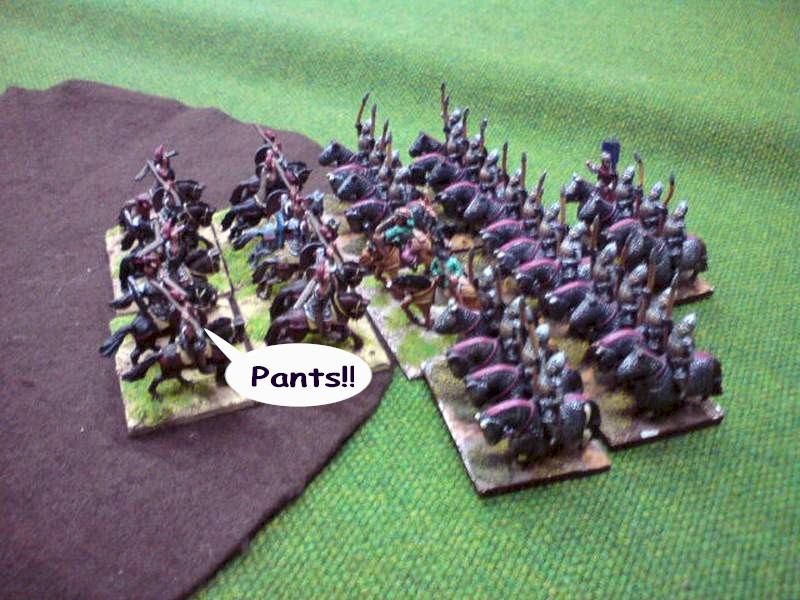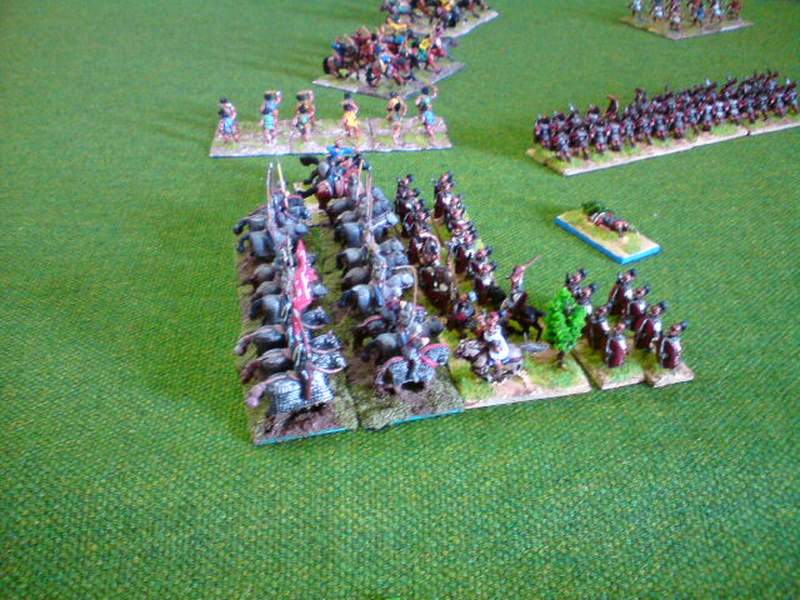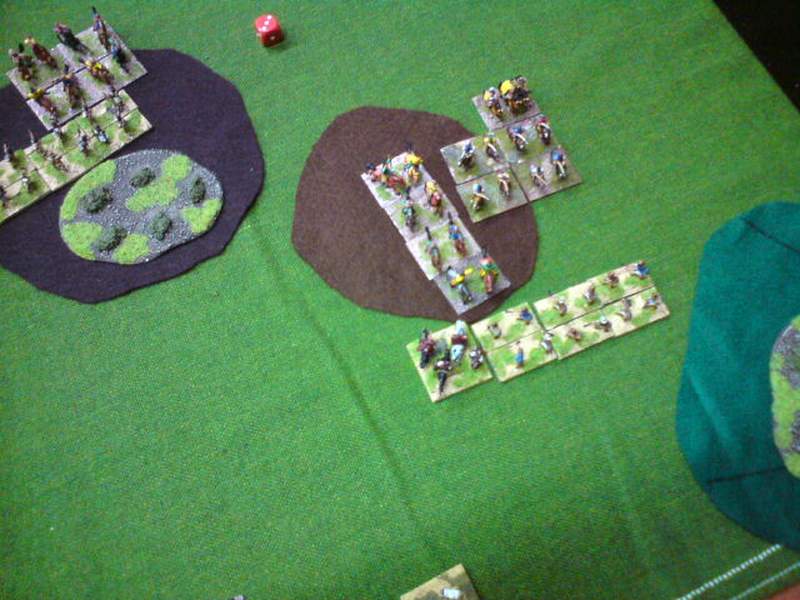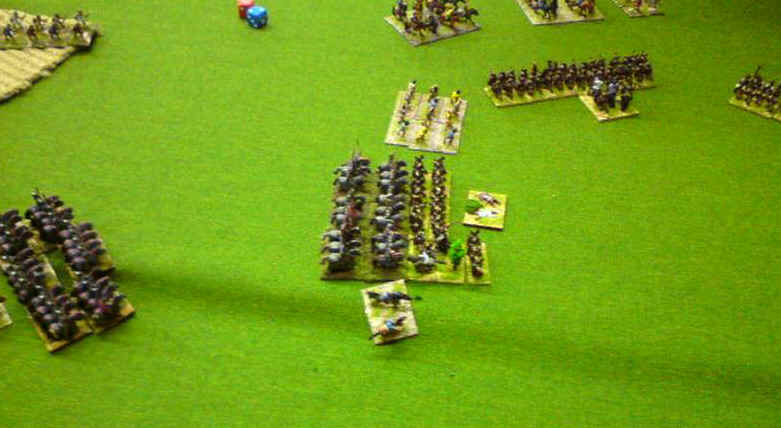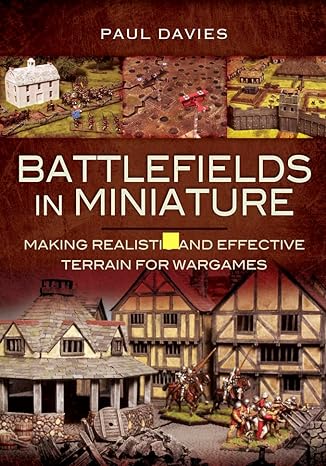Field of Glory Wargaming at Warfare 2008
Its Warfare!! With the world economy in freefall and snow in the air Central London convened at the Papier-Mache Space Cafe in Reading for a big fat fry up to put the world to rights and soak up the previous nights red wine.
Under the watchful stewardship of Tim Child the once amusingly shambolic Warfare was now a slick well oiled machine - even the vague smell of old peoples wee had seemed to have disappeared from the bowling green on which the fields of battle were arrayed ("Has it been raining Albert?" "No Maude, we're playing indoors at the Rivermead today remember" "Oh, its probably just Frank again then. At least its not Crown Green or it'd be trickling back down the slope towards us all through the game, which I find so off-putting")
After "Roll Call", despite my series of defeats against massed cataphracts, I'd felt I had started to learn something, and so like a smack addict chasing that one perfect hit I found myself tightening the the ties of lead addiction around my bicep as I brought my Late Republican Romans to Reading.
The choice of Romans was largely driven by the fact I'd bought and painted a complete LRR army just recently and I wanted to use them, and also some Gauls who had also recently seen the benefit of my improved brush technique. The science however was that in a restricted period (RoR/IF/LT books only) it would work as a decent army too. The legions were mostly Skilled Swordsmen in case I fought other Roman armies (or barbarians) - however points restraints and a wish to make them "not too hard to take on" meant I fitted in 6 downgrade legionaries. They were fielded in big units so I could attach generals to them and make large numbers of bases virtually invincible (or so I hoped). I had only TCs as I didn't expect to suffer from much shooting in this period.
I had 3 units of LH, and an odd deployment order that saw some of them coming
out at the end - where they were meant to combine with my cavalry unit to drive
off and overpower enemy bow armed LH. Likewise my 3 units of foot skirmishers
included some late-deployed protected velites to out-match the enemy
skirmishers, and hopefully the result would be that I would pick up some
"cheap" units by mugging unprepared enemy skirmishers. Finally the
Dacian ally was there to provide an unexpectedly large rough terrain force
capable of outmatching the typical classical era rough terrain force of 2 x 6 Thracian
types - and with a ally general permanently attached, and the Ligurians for rear
support as well, the Dacians should be capable of doing some serious - and again
unexpected - damage in rough terrain.
Unfortunately I'd forgotten to bring a camera battery, so the first day I was stuck with using my camera on my phone to take shots - hence the scarcity, and the uneven quality.
I again submitted the list before playing a single game with it.
Game 1 saw me facing .... another light horse and cataphract army, just like my nemeses (is that a word? Plural of nemesis? Spellcheck likes it, but it could also be a type of small south east Asian aquatic lizard that a bloke at Microsoft responsible for building the dictionary function in Seattle once had as a pet in college for all I know?) from Roll Call - even some of the figures were the same as the army was led by Dave Ruddock, co-club-member of the same Phil who's 28 cataphracts had just about, after a desperate struggle, managed to crush me mercilessly only a few weeks before.
You can see the list and find out all about the Parthians here
Pictures of Parthian Troops from my Ancients Photo Directory
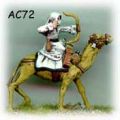 |
 |
 |
The Parthians were such masters of terrain their General was practically called Lee, and their +4 aggression meant they ended up with Steppes. A few very cunning choices by Lee, including a small gentle hill with rough ground on it meant I could not even deploy my possible 4 pieces (without also having open spaces in the list) as there were too few uneven or rough bits left for me to choose after the Parthians has snaffled them up and we set out with Carrhae firmly in both our minds.
I had seriously considered turtling up, but the lack of terrain to hide between, and my choice of a v-neck sweater that morning meant this negative option was denied me, so instead I hoped to rush across the table and push some of the enemy skirmishers off the edge of the world ("aaaaaaarrrrrrhggggghhhhhhhhhhhhhhhh!!!!!!!!!!!! We're fallllllliiiiiiiiinnnnnnnnggg!") to rack up some points using the fast moving Numidians to punch quickly to the back of the table, trapping half the Parthian skirmishers against my advancing wall of Dacians and also nick a few more units anyway with my in theory brilliant Numidian light horse. This meant also using the legions as linebackers to fend off cataphracts whilst my vulnerable Dacians took advantage of a lot of uneven ground on my right to keep away from metal monsters, and used their unit size to protect themselves from shooting.
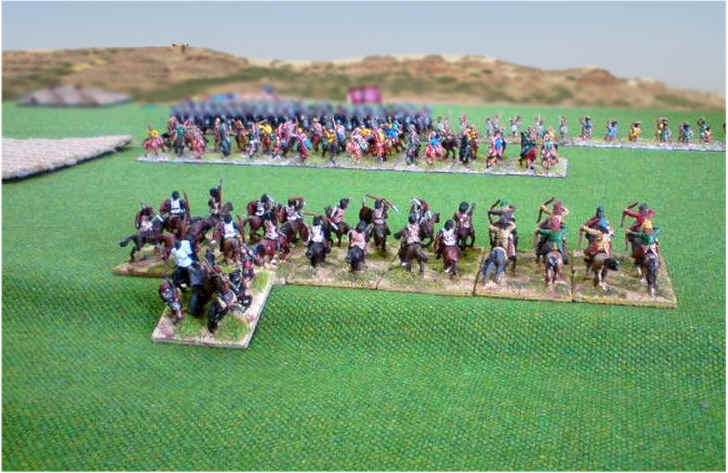
The Numidians rushed forward, and it looked like they would trap the Parthian bowmen in front of the cataphracts - a double whammy as it would also keep the heavies tied up (although I am told some of them quite like that occasionally).
But like all my great theories, in FoG, it quickly fell apart under the harsh investigation of the IGO UGO (and we all move every turn) move sequence....
On my right however the massed Dacians were pushing forward, and doing a reasonable job of withstanding shooting - although the Roman skirmishers had not done so well in the early exchanges, and had suffered a coupe of disruptions (look out for the dead guys - they are disruption markers from Donnington.)
With the Parthians shoot and scoot tactics the battle was progressing swiftly, and ideally for me, the 2 cataphract units were distracted and largely out of the game at the half way stage. However my light horse had become split up and isolated, and despite a couple of attempts at charges, they had failed to catch up with any of the evading Parthians and now the two units in the middle were looking a touch isolated and surrounded. I had managed to instigate a one-on-one fight on my left, but the bow-only Parthian light horse were proving tough opponents - or more accurately my Numidians with javelins and shields were rather miffed to realise that this only gave them a slight advantage in the impact phase of combat - which the Parthians outweighed with shooting and better combat dice anyway!
On the right, with the Cataphract threat safely out of the way the Dacians were confident to push out of the terrain and chase the Parthians away. Things were looking good, right up until the point that I remembered that units that evade off table only count as half-losses compared to those who are killed. So even if I could squeeze nearly all of the Parthians off table, it would not allow me to win the game without actually catching and killing some of their units as well.... Doh!
On the "catching and killing" front the Parthians in the middle were doing just that to my rather disgruntled Numidians. Not only had they found that their legendary status conferred them virtually no combat advantages, but the repeated shooting of the Parthians and their far greater numbers meant the Numidians morale was slipping down faster than a cold beer in dusty bar in a hot summer in Susa in a dust storm.
As the Romans continued what they already now realised was a totally futile and pointless attempt to push the Parthians off table, innumerable units of light horse started slipping through the gaps in their lines, just because they could. With the total collapse and destruction of my light horse thrust in the middle there was now ample room for the other Parthians to escape to the left of the table, as my Legions had no way of getting there to cut off their escape.
In one almost bright upside the Roman cavalry had managed to tempt one unit (out of 2) cataphracts to charge them in some uneven ground, denying the Parthians the luxury of the lancer plus, and causing the close formation monsters to lose some bases through disorder. But no! Only the bases in the terrain count disordered - and there were only 2 of them, so the terrain had no effect on the Parthians at all!
In the middle the other Parthian unit had charged into a legion. This should be an interesting fight. Dead equal at impact, both sides led by generals, I had rear support and the Parthians did not, and in melee they would be 1 factor up but I had the advantage of 25% more men fighting.
Of course, I got totally crushed like a chainmail-clad butterfly on a wheel (apparently that was a close 2nd as the title for Metallica's newest album..), lost two bases in short order and fell to fragmented in a couple of bounds or combat whilst the Parthians were totally unscathed.
On my right, the Parthians who had slipped through my lumbering lines were now harassing my skirmishers, who found themselves totally not helped at all by the paltry and pathetic bits of terrain left by the Parthian commander.
And as the Dacians advanced the Parthian light horse liberally applied KY lubricant to themselves and their horses (in a routine they had practiced maybe just a few times beyond the bounds of what was strictly necessary from a pure military perspective back in barracks that spring) and escaped, leaving only 2 units at the mercy of the rather irritated Dacians.
Finally though, with only one Parthian unit fleeing off table, the Roman army fell through weight of losses. The Cavalry unit had died, 3 units of light horse had been swept away by more numerous and clearly better equipped opponents, the skirmishers had been captured and the fortified baggage had proved a total waste of points in holding out for just 1 turn.
The game was over - a huge defeat.
Post Match Summary
My balanced army came a real cropper here against a nearly one-dimensional foe with a plan to exploit Steppe terrain.
If I had realised from the off that there was little real value in fleeing enemy units off table I might still have been tempted to deploy in a corner and hide - but this could also have been undone by an enemy flank march (which they had apparently considered).
Instead however I had tried a constructive plan, and some parts of it had been looking good - the cataphracts were distracted and only beat 2 of my units, the Dacians were protected by their deployment position. But the Numidians were actually found to be worse than useless against large numbers of bow armed light horse, and my light infantry skirmishers had nowhere to hide from the enemy mounted.
Hannibal's Post Match Analysis
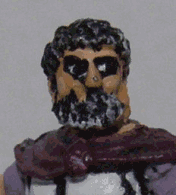 Well,
normal service is clearly resumed.
Well,
normal service is clearly resumed.
Shall we focus on the positives for a while?
Right, that's out the way then.
Now lets talk about what you did wrong.
This is clearly another example of you not understanding the rules, and paying for it. You win the battle by killing enemy units. That's it - even those numptie Roman generals I pasted week in week out (before that t-sser Scipio turned up of course) knew that - but at least they knew they weren't capable of winning battles against a genius like me and avoided set piece combats where they could and just ground me down through attrition and the scorched earth policy. But you just walked into it like a total fool, and frankly you got what you deserved.
And the Numidians...? I know historically they were feared famous fighters, who dominated the light horse exchanges in the Punic wars. But whoever wrote these rules and lists gave you a very big clue.
Numidians - 7 points, Bw only LH - 8 points, Bw & SW light horse - 10 points.
Now, have an educated stab at guessing which is going to be better....?
You win by killing enemy units. Taking terrain, useless. Fleeing some of the enemy off table - almost useless. Your army could not really hope to kill any Parthians, so basically you designed it wrong.
This may well be a long weekend.
NEXT!!!
The stage was set for the next round
The Ancient Army List Index
The Rise of Rome (280 BC to 25 BC) Mid Republican Roman ; Late Republican Roman ; Gallic ; Pyrrhic ; Later Carthaginian ; Ancient Spanish ; Later Macedonian ; Later Seleucid ; Later Ptolemaic ; Attalid Pergamene ; Numidian or early Moorish ; Pontic ; Early Armenian ; Parthian ; Later Jewish ; Illyrian ; Spartacus Slave Revolt ; Bosporan ;
Storm of Arrows - Western Europe in the Later Middle Ages (1300 AD to 1500 AD) Medieval French ; 100-yrs War English (Continental) ; 100-yrs War English (Britain) ; Later Medieval Scots ( Britain) ; Later Medieval Scots (Continental) ; Later Scots Isles & Highlands ; Medieval Welsh ; Later Anglo-Irish ; Medieval Irish ; Low Countries ; Later Medieval German ; Italian Condotta ; Swiss ; Free Company ; Medieval Burgundian ; Medieval Danish ; Medieval Swedish ; Medieval Castilian ; Medieval Crown of Aragon ; Medieval Portugese ; Later Granadine ; Navarrese ; Ordonnance French ; Wars of the Roses English ; Ordonnance Burgundian ; Santa Hermandad Nueva Castilian
Immortal Fire - The Greek, Persian & Macedonian Wars (550 BC - 146 BC)
Classical Greek ;
Early Achaemenid Persian ;
Lydian ;
Thracian ;
Syracusan ;
Early Carthaginian ;
Skythian or Saka ;
Kyrenean Greek ;
Late Dynastic Egyptian ;
Alexandrian Macedonian ;
Later Achaemenid Persian ;
Classical Indian ;
Early Successor ;
Early Sarmatian ;
Galatian ;
Hellenistic Greek ;
Graeco-Bactrian ;
Graeco-Indian ;
Indo-Greek :
Legions Triumphant - Imperial Rome (25 BC to 493 AD) Dominate Roman ; Principate Roman ; Foederate Roman ; Later Sarmatian ; Early German ; Dacian or Carpi ; Ancient British ; Caledonian ; Early Alan ; Jewish Revolt ; Sassanid Persian ; Kushan or Indo-Skythian ; Palmyran ; Early Frankish, Alamanni, Burgundi, Limigantes, Rugian, Suevi or Turcilingi ; Western Hunnic ; Early Visigothic & Early Vandal ; Early Ostrogothic, Herul, Sciri or Taifali ; Early Anglo-Saxon, Bavarian, Frisian, Old Saxon or Thuringian ; Gepid or Early Lombard ; Early Scots Irish ; Early Pictish ; Hephthalite Hunnic ;
Swords & Scimitars - The Crusades (1096 AD to 1311 AD) Early Crusader ; Later Crusader ; Fatimid Egyptian ; Georgian ; Seljuk Turk ; Cuman ; Komnenan Byzantine ; Post Latin Conquest Byzantine ; Ilkhanid Mongol ; Mamluk Egyptian ; Cilician Armenian ; Syrian States ; Khwarazmian ; Ayyubid Egyptian ; Middle Serbian ; Middle Bulgarian ; Medieval Cypriot ; Latin Greece ; Pecheneg ;
Eternal Empire - Eastern Europe and the Rise of the Ottomans (1300 AD to 1500 AD) Early Ottoman Turkish ; Later Ottoman Turkish ; Tatar ; Later Russian ; Later Serbian Empire ; Later Bulgarian ; Later Lithuanian ; Later Polish ; Later Teutonic Knights ; Catalan Company ; Middle Hungarian ; Moldavian or Wallachian ; Albanian ; Timurid, White Sheep Turcoman or Black Sheep Turcoman ; Later Hungarian ; Hussite ;
Decline & Fall - Byzantium and Islam (493 AD to 1071 AD) Early Byzantine; Maurikian Byzantine ; Thematic Byzantine ; Nikephorian Byzantine ; Later Moorish ; Later Visigothic ; African Vandal ; Italian Ostrogothic ; Early South Slav ; Lombard ; Avar ; Arab Conquest ; Early Bulgar ; Ummayad Arab ; Abbasid Arab ; Early North African Dynasties ; Khurasanian Dynasties ; Bedouin Dynasties ; Dailami Dynasties ; Pecheneg ; Ghaznavid ; Western Turkish (includes Khazar);
Wolves From The Sea - The Hairy European Dark Ages Post Roman British ; Early Welsh ; Later Scots Irish ; Merovingian Frankish ; Later Pictish ; Early Slavic ; Middle Anglo Saxon ; Astur Leonese ; Andalusian ; Early Navarrese ; Carolingian Frankish ; Viking ; Magyar ; Great Moravian ; Early Scots ; Rus ; Norse Irish ; Early Medieval French ; Early Medieval German ; Norman ; Early Polish ; Anglo Danish ;
Swifter Than Eagles - The Biblical Book Nubian ; Early Libyan ; Later Sumerian or Akkadian ; Early Nomad Allies ; Old or Middle Kingdom Egyptian ; Hyksos ; Mitanni ; Syro-Canaanite ; New Kingdom Egyptian ; Later Minoan or Early Mycenaean ; Hittite Empire ; ; Middle or Early Neo-Assyrian ; Later Mycenaean or Trojan ; Sea Peoples ; Philistine ; Phoenician Allies ; Neo-Hittite And Aramaean ; Later Hebrew ; Mannaean Allies ; Libyan Egyptian ; Urartian ; Median ; Neo-Elamite ; Proto-Arab Allies ; Cimmerian or Early Skythian ; Neo-Assyrian Empire ; Phrygian Allies ; Kushite Egyptian ; Neo-Babylonian Empire ;
Oaf of Fealty - Early Medieval Europe Feudal Catalan and Early Crown Of Aragon ; Early Hungarian ; Taifa Andalusian ; Feudal Navarrese and Aragonese ; Feudal Castilian Leonese or Portuguese ; Fanatic Berber ; Italo-Norman ; Feudal French ; Imperial German ; Feudal German ; Communal Italian ; Papal Italian ; Early Scots Isles And Highlands ; Feudal Scots ; Early Russian ; Feudal Polish ; Anglo-Norman ; Later Welsh ; Early Lithuanian or Samogitian ; Wendish Prussian or Estonian ; Early Medieval Frisia and Other Free Cantons ; Post-Viking Scandinavian ; Early Plantagenet English ; Later Sicilian ; Early Medieval Irish ; Early Anglo-Irish ; Early Teutonic Knights ; Mongol Invasion ; Early Granadine ; Middle Plantagenet English ;
Empires of The Dragon - China, Korea and Japan Erlitou-Shang Chinese ; Early Northern Barbarian Allies ; Early Zhou Chinese ; Yayoi Japanese ; Early Horse Nomad ; Ko Choson Korean ; Warring States To Western Han Chinese ; Qiang And Di ; Three Kingdoms Korean ; Eastern Han Chinese? ; Three Kingdoms W Jin And S Dynasties Chinese ; Kofun Nara Japanese ; Northern Dynasties Chinese ; Later Hindu North Indian ; Later Hindu South Indian ; Central Asian City States ; Western Wei To Early Tang Chinese ; ; Later Horse Nomad ; Tibetan ; Nepalese Allies ; Parhae Korean ; Late Tang To Five Dynasties Chinese ; Khmer Or Champa ; Thai Allies ; Nanzhao ; Pyu Burmese Allies ; Koryo Korean ; Early Heian Japanese ; Pagan Burmese ; Liao ; Song Chinese ; Xi Xia ; Ghurid Afghan ; Jin ; Late Heian To Muromachi Japanese ; Japanese Warrior Monk Allies ; Mongol Conquest ; Moslem Indian Sultanates ; Medieval Indonesian Or Malay ; Yuan Chinese ; Medieval Burmese ; Ming Chinese ; Yi Korean
Blood and Gold - The Americas Olmec ; Teotihuacan ; West Mexican ; Zapotec or Mixtec ; Toltec ; Chinantec ; Aztec ; Tarascan ; Tlaxcalan Confederacy ; Mayan ; Mochica ; Chanca ; Chimu ; Hatun-Colla ; Canari ; Inca ; Mapuche or Araucanian ; Amazonian Forest Tribes ; Tupi ; Chichimec ; Pueblo Culture ; Mound-Builder Culture ; South-Eastern Woodland Culture ; Timucuan ; Eastern Woodland Culture ; Plains Culture ; Pacific North-West Culture
View My Stats for My FoG Pages


